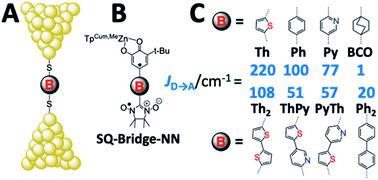当前位置:
X-MOL 学术
›
Chem. Sci.
›
论文详情
Our official English website, www.x-mol.net, welcomes your feedback! (Note: you will need to create a separate account there.)
Transferrable property relationships between magnetic exchange coupling and molecular conductance
Chemical Science ( IF 8.4 ) Pub Date : 2020-10-08 , DOI: 10.1039/d0sc04350h Martin L. Kirk 1, 2, 3, 4, 5 , Ranjana Dangi 1, 2, 3, 4 , Diana Habel-Rodriguez 1, 2, 3, 4 , Jing Yang 1, 2, 3, 4 , David A. Shultz 4, 6, 7, 8 , Jinyuan Zhang 4, 6, 7, 8
Chemical Science ( IF 8.4 ) Pub Date : 2020-10-08 , DOI: 10.1039/d0sc04350h Martin L. Kirk 1, 2, 3, 4, 5 , Ranjana Dangi 1, 2, 3, 4 , Diana Habel-Rodriguez 1, 2, 3, 4 , Jing Yang 1, 2, 3, 4 , David A. Shultz 4, 6, 7, 8 , Jinyuan Zhang 4, 6, 7, 8
Affiliation

|
Calculated conductance through Aun–S–Bridge–S–Aun (Bridge = organic σ/π-system) constructs are compared to experimentally-determined magnetic exchange coupling parameters in a series of TpCum,MeZnSQ–Bridge–NN complexes, where TpCum,Me = hydro-tris(3-cumenyl-1-methylpyrazolyl)borate ancillary ligand, Zn = diamagnetic zinc(II), SQ = semiquinone (S = 1/2), and NN = nitronylnitroxide radical (S = 1/2). We find that there is a nonlinear functional relationship between the biradical magnetic exchange coupling, JD→A, and the computed conductance, gmb. Although different bridge types (monomer vs. dimer) do not lie on the same JD→A vs. gmb, curve, there is a scale invariance between the monomeric and dimeric bridges which shows that the two data sets are related by a proportionate scaling of JD→A. For exchange and conductance mediated by a given bridge fragment, we find that the ratio of distance dependent decay constants for conductance (βg) and magnetic exchange coupling (βJ) does not equal unity, indicating that inherent differences in the tunneling energy gaps, Δε, and the bridge–bridge electronic coupling, HBB, are not directly transferrable properties as they relate to exchange and conductance. The results of these observations are described in valence bond terms, with resonance structure contributions to the ground state bridge wavefunction being different for SQ–Bridge–NN and Aun–S–Bridge–S–Aun systems.
中文翻译:

磁交换耦合与分子电导之间的可传递性质关系
通过在一系列Tp Cum,Me ZnSQ-Bridge-NN络合物中,通过Au n –S–Bridge–S–Au n(桥梁=有机σ/π-系统)结构计算的电导与实验确定的磁交换耦合参数进行比较,其中Tp Cum,Me =氢三(3-枯烯基-1-甲基吡唑基)硼酸酯辅助配体,Zn =抗磁性锌(II),SQ =半醌(S = 1/2),NN =硝酰基硝基氧自由基(S = 1 / 2)。我们发现,双自由基磁交换耦合J D→A与计算出的电导g mb之间存在非线性函数关系。。尽管不同的桥类型(单体vs.二聚体)不在相同的J D→A vs. g mb曲线上,但是单体桥和二聚体桥之间存在比例不变,这表明两个数据集之间存在比例关系J D→A的缩放。用于交换和电导由给定的桥片段介导,我们发现,距离相关衰减常数的电导(比率β克)和磁交换耦合(β Ĵ)并不等于统一,这表明在所述隧穿能隙的固有差异, Δ ε,和桥桥电子耦合,ħ BB并非直接可转让的属性,因为它们与交换和电导有关。这些观察结果以价键术语描述,对于SQ–Bridge–NN和Au n –S–Bridge–S–Au n系统,共振结构对基态桥波函数的贡献不同。
更新日期:2020-10-08
中文翻译:

磁交换耦合与分子电导之间的可传递性质关系
通过在一系列Tp Cum,Me ZnSQ-Bridge-NN络合物中,通过Au n –S–Bridge–S–Au n(桥梁=有机σ/π-系统)结构计算的电导与实验确定的磁交换耦合参数进行比较,其中Tp Cum,Me =氢三(3-枯烯基-1-甲基吡唑基)硼酸酯辅助配体,Zn =抗磁性锌(II),SQ =半醌(S = 1/2),NN =硝酰基硝基氧自由基(S = 1 / 2)。我们发现,双自由基磁交换耦合J D→A与计算出的电导g mb之间存在非线性函数关系。。尽管不同的桥类型(单体vs.二聚体)不在相同的J D→A vs. g mb曲线上,但是单体桥和二聚体桥之间存在比例不变,这表明两个数据集之间存在比例关系J D→A的缩放。用于交换和电导由给定的桥片段介导,我们发现,距离相关衰减常数的电导(比率β克)和磁交换耦合(β Ĵ)并不等于统一,这表明在所述隧穿能隙的固有差异, Δ ε,和桥桥电子耦合,ħ BB并非直接可转让的属性,因为它们与交换和电导有关。这些观察结果以价键术语描述,对于SQ–Bridge–NN和Au n –S–Bridge–S–Au n系统,共振结构对基态桥波函数的贡献不同。


























 京公网安备 11010802027423号
京公网安备 11010802027423号